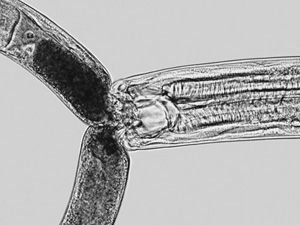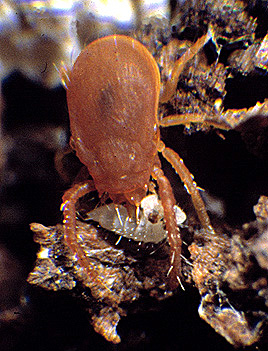| • Table of Contents • |
Summer 2008 - Vol. 8/No. 3
Effects of Agricultural Management on Nematode – Mite Assemblages: Studies suggest they provide information on soil health, fertility
by Sara Sánchez-Moreno, Nicole Nicola, Howard Ferris, and Frank Zalom
A predator nematode devouring its prey.

Soil mite dines on a springtail (or Collembola).
Soil nematodes are highly diverse in their habitats and feeding habits. Several million of these multicellular but microscopic organisms may inhabit a square meter of soil, living in water films surrounding soil particles and aggregates of soil particles, as well as in roots and decomposing plant material.
The food sources for different groups of soil nematodes include bacteria, fungi, other nematodes, arthropods, and plant roots. Their numbers tend to be related to the abundance of their food and with those of other soil animals that may be their predators or that may be feeding on the same food sources and adapted to the same environmental conditions. Given their diversity, soil nematodes are useful indicators of the whole soil food web, that assemblage of organisms supported by plants and the herbivorous organisms that feed on them. Accordingly, they provide indication of the functions and services provided by the soil ecosystem.
Similarly, the high diversity of microarthropod communities, and their intricate relationships within the soil ecosystem qualify them as bioindicators of the soil food web and functioning of the soil ecosystem. Mites are some of the most abundant soil arthropods and they play important roles in the interactions of soil biota; some are effective predators capable of regulating and suppressing populations of their prey while others indicate levels of ecological disturbance and anthropogenic impact.
The objectives of our study were (i) to determine the effects of organic and conventional management systems, and differing intensity of tillage, on the soil biota through analysis of nematode and mite assemblages, and (ii) to determine the quantitative relationships between nematodes and arthropods in the soil.
Methods
Soil samples were collected from the 0.4 ha plots of the organic (Org) and conventional (Conv) management systems of the Long Term Research in Agricultural Systems (LTRAS) project. Each plot is divided into two subplots; standard tillage and conservation tillage. No-till treatments were included in the Org plots by hand-weeding two 3-m2 microplots. Thus, five treatments were sampled: Conv-Standard Tillage (CST), Conv-Conservation Tillage (CCT), Org-Standard Tillage (OST), Org-Conservation Tillage (OCT), and Org-No Tillage (ONT). All the treatments were planted with tomato (2005) and corn (2006). There were three replicates of each treatment and three samples were taken in each treatment plot. Thus, 45 samples were collected in March, June, August, and November 2005, and April, May/June, August/September, and November 2006.
Arthropods were extracted, identified and classified into four trophic groups: fungivores and/or saprophages (FS), predators, omnivores, and algivores. Nematodes were extracted, identified and classified into five main trophic groups: predators, omnivores, plant-feeders, fungal-feeders and bacterial-feeders. Soil food web indices (Enrichment Index, Structure Index, Channel Index and Basal Index), were calculated based on the nematode data.
Results

Figure 1. Number of nematodes and nematode taxa in conventional plots with standard (CST) and conservation (CCT) tillage and organic plots with standard (OST), conservation (OCT) and no (ONT) tillage.

Figure 2. Temporal patterns of the Structure Index (SI) and abundance of predatory mites (PredM). Sampling time (1-8) correspond to March, June, August, and November 2005, and April, May/June, August/September, and November 2006

Figure 3. Two biological associations detected in different agricultural management systems.
The effects of different agricultural practices were reflected in both the nematode and the mite community. Of the 37 nematode taxa found in soil samples, some nematodes, such as the genera Panagrolaimus, Prismatolaimus, Mesorhabditis, Plectus, Tylenchorhynchus and Helicotylenchus were more abundant in the organic treatments, some of them responding rapidly to the organic matter provided by incorporation of cover crops in the Org management. On average, both number of nematodes and number of taxa were greater in Org than in Conv treatments, in a sequence from low (ONT) to high (CST) disturbance (Fig. 1). Organic or conventional management was the most important factor determining the taxa composition of the nematode community.
The Enrichment Index (EI) was higher in Org that in Conv plots (P< 0.01), indicating more abundant microbial populations, more rapid organic matter decomposition and higher soil fertility.
Abundance of predatory nematodes was higher in the Org plots than in CST. As expected, the Structure Index (SI), indicator of soil food web length and connectance, was higher in the ONT treatment than in Conv plots (P< 0.05), since the application of fertilizers and pesticides is often correlated with the reduction of the higher links of the soil food web. Further, the Structure Index, based mainly on generalist and specialist predator nematode groups, was a good indicator of the abundance of predatory mites (Fig. 2). Agricultural disturbance also affected predatory mites, which were in greatest abundance in ONT and OCT and in lowest abundance in CST.
The Channel Index (CI), indicator of slower organic matter decomposition mediated by fungi, and the Basal Index, indicator of stressed and depleted soil food webs, were both significantly greater in Conv than in Org organic plots (P< 0.01), indicating lower availability of organic matter and perturbed soil food webs. Organic matter in Conv is primarily derived from leaf litter and crop residues with high C/N ratios; as the decomposing organic matter becomes more recalcitrant, it is more conducive to fungal decomposition, and the ratio of fungal/bacterial feeding nematodes increases. Thus, abundance of fungal-feeding nematodes was higher in Conv treatments. Fungivore and saprophage mites, on the contrary, were affected separately by management and tillage, with greatest abundances in Org and CT/NT (P< 0.05). Algivore mites were only affected by management system and were at greatest abundance in Conv plots.
We constructed a model describing two different soil assemblages based on the associations among experimental treatments, soil food web indices and trophic groups of nematodes and mites (Fig. 3). Each association is composed of nematode and mite trophic groups that are most abundant in the same treatments.
Association I is composed of bacterial-feeding (Ba) and predatory nematodes (P) and arthropods (PredM), and is typically present in the OCT/ONT plots. High values of the Structure Index (SI) and the Enrichment Index (EI) are positive predictors of this association. This association, together with omnivore nematodes (O) and arthropods (OmnM), and fungivore and saprophage mites (FS), comprised the biological assemblage in the Org management system, irrespective of tillage treatment (Fig.3). Absence of physical perturbation and chemical inputs in organic-no till plots led to a nematode-mite assemblage characteristic of high soil food web structure, including abundant predators and a large bacterial-feeding community, probably supported by large microbial populations, which provides a consistent food source for the higher trophic levels of the soil food web. In contrast, Association II is composed of fungal (Fu) and plant-feeding (Pp) nematodes and fungal and algivorous arthropods (Alg); it is indicated by high values of the Basal Index (BI) and the Channel Index (CI). It reflects the presence of short and depleted soil food webs with low diversity in Conv plots. Thus, descriptive indices of the soil food web, based on the structure of the nematode assemblage, also provided a useful indicator of the structure and functions of the soil mite populations.
Organic management and low tillage in crop rotation systems in California’s Central Valley greatly increased the abundance and diversity of soil organisms. Overall, Org/NT supported soil food webs that provide higher levels of beneficial food web services. The services include greater suppression of plant-feeding organisms and more rapid organic matter decompositions. Although further steps are needed to relate crop productivity to organism diversity and food web services, our studies suggest that bioindicators such as nematodes and mites may provide valuable information on soil health and fertility.